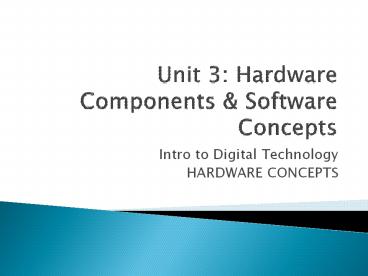Unit 3: Hardware Components - PowerPoint PPT Presentation
Title:
Unit 3: Hardware Components
Description:
... Sometimes called system board Main circuit board of the system unit Many electronic components are attached to the motherboard Expansion slots ... PC s: Intel ... – PowerPoint PPT presentation
Number of Views:97
Avg rating:3.0/5.0
Title: Unit 3: Hardware Components
1
Unit 3 Hardware Components Software Concepts
- Intro to Digital Technology
- HARDWARE CONCEPTS
2
GPS Standard
- IT-IDT-4 Identify, describe, evaluate, select,
and use appropriate technology. - IT-IDT-5 Understand, communicate, and adapt to a
digital world.
3
What is a computer?
- Electronic device that accepts, processes,
produces results, and stores data - Data
- Collection of unprocessed items
- Text, numbers, images, audio, and video
- Information
- Conveys meaning and is useful
- Ex. Data is input to create a grade report
4
Information Processing Cycle
5
Components of a Computer
- Hardware
- Electric, electronic, and mechanical components
- Input devices
- Output devices
- System unit
- Storage devices
- Communications devices
6
Input Devices
- Any hardware component that allows you to enter
data and instructions into a computer - Keyboard
- Mouse
- Microphone
- Scanner
- Digital camera
- Web cam
7
Output Devices
- Any hardware component that conveys information
to one or more people - Printer
- Monitor
- Speakers
- Portable media player
8
System Unit
- A case that contains electronic components of the
computer used to process data
9
Motherboard
- Sometimes called system board
- Main circuit board of the system unit
- Many electronic components are attached to the
motherboard - Expansion slots
- Processor chips
- Memory slots
10
Processor or CPU
- Interprets and carries out the basic instructions
that operate a computer
11
Processor
- Control Unit
- Component of processor that directs and
coordinates operations - Like a traffic cop it interprets each
instruction issued by a program and then
initiates the appropriate action to carry out the
instruction
12
System Clock
- Controls the timing of all operations
- Clock speed
- Pace of clock
- Gigahertz (GHz) one billion ticks of the system
clock per second - Faster clock speedmore instructions the
processor can execute per second - Does the system clock keep track of current date
and time? - First computers 30 MHz
- Current 3 GHz
13
Comparison of Processors
- Leading chip manufacturers
- Intel
- AMD (Advanced Micro Devices)
- IBM
- Motorola
- Todays high performance PCs Intel Core
- Less expensive PCs Pentium or Celeron
14
Processors
- Multi-core processor
- Single chip with 2 or more processors
- Dual-core 2 separate processors
- Quad-core 4 separate processors
- Increases overall performance
- Especially noticeable when running multiple
programs - Email, antivirus software, spyware remover, IM,
media player, CD burning software, and photo
editing software
15
Memory
- Store instructions, data needed by those
instructions, and the results of processed data - One or more chips on motherboard
- Stores 3 basic categories
- Operating system
- Application programs
- Data being processed by
- application programs
16
Byte
- Character, basic storage unit of memory
- Each byte has an address
- Unique number that identifies the location of the
byte in memory
17
Memory Sizes
18
RAM
- Random access memory
- Temporary memory
- More information processed more RAM needed
- Volatile loses its contents when power is
removed - Examples
- Operating system interface
- Browser windows
- Paint program
- More RAM faster response from computer
19
Cache
- Pronounced cash
- Temporary storage for faster viewing
- Ex. Web pages, images, media
20
ROM
- Read-only memory
- Permanent storage
- Non-volatile not lost when power is removed
- Cannot be modified
- Ex. ROM chips in printers contain data for fonts
- Ex. When your system boots up
21
Flash Memory
- Nonvolatile
- Fast
- Examples
- Downloading music on iTunes to your iPod
- Storing phone numbers on your phone
- Pagers
- Digital cameras
22
Expansion Slots/Adapter Cards
- Motherboard
- To enhance functions or provide connections to
devices
23
Ports
24
Connectors
25
4 Components of a Computer
- Input
- Storage
- Processing
- Output































